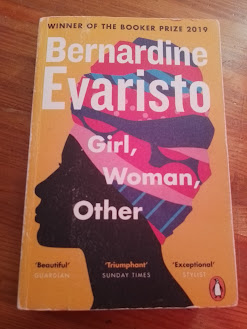Fictional book review: Girl, Woman, Other (2019) by Bernadine Evaristo.
I am back again to bring yet another fascinating review and am keeping with the LGBTQIA+ theme. For this one I am diving into what quickly became my favourite book when I first read it - Bernadine Evaristo's Girl, Woman, Other (2019). From the first page, the first sentence even, I knew there was something special about this and as I read it I could easily understand why it won the Booker prize in 2019 (alongside Margaret Atwood's The Testaments 2019) I think the first thing I noticed was Evaristo's use of punctuation and capital letters because without giving too much away, she rather tends to challenge the grammatical rules with which we are familiar with as I found on page one:
‘to her right is the bend in the river as it heads east past Waterloo
Bridge towards the dome of St Paul's’.¹
This not only drew me in to Amma's world but also Evaristo's world as a writer. I find that her craft is such a joy because of the way she structures her words, sentences and paragraphs. It was funny because I realised you have to pay close to attention to her structuring, something which at first, I failed to realise. But there are other factors that make this novel such an amazing novel to read (hence, I'm reviewing it for you!)
The thing for me that makes this novel stand out the most is the characters and the themes Evaristo is trying to get across to the reader. This novel just screams of a want for an equal society and the struggles of being different. But for Girl, Woman, Other, being different comes in more than one way. Here she has tackled the struggles of racial difference, gender difference, difference of sexuality and age difference. First of all, as readers, we get introduced to Amma and her friend Dominique who are both black, and lesbian. The novel is opens in modern-day society but explores the livelihoods of the characters, as they have grown up, demonstrating the struggles of the different characters across decades. This has shown how factors such as being black or being a lesbian (and a woman actually) have impacted on the characters' chances/decisions. For Amma and Dominque, as an example, ‘they met in the eighties at an audition’² and despite ‘being put up for parts such as slave, servant, prostitute, nanny or crim'³ they were ‘still not getting the job’.⁴ Partly, I think that was more a racial factor than due to their gender or sexuality but as a lot of people know, the 1980s was also not easy for those who were a woman and/or not heterosexual as much as it was hard for black people. That is not to say society is perfect now but that it was much harder back then in comparison to the present day.
Evaristo's novel also challenges these modern-day struggles too. Taking the character of Megan and later Morgan, she enables people's perceptions to be challenged. Megan is a female character who becomes non-binary and changes their name to Morgan. Their interactions with others is interesting in the novel. It is less about the negative comments but more about people understanding what it is to be non-binary which for me I liked. I hate reading about how people who are not cisgendered just keep getting hate, as if that is the only aspect of their journey. The novel establishes the good things about not being cisgendered and the things we can learn. This is what I mean by challenging people's perceptions, the reader's to be precise. As you can read about Morgan's journey, you will find their story interwoven with some of the other characters. When reading Girl, Woman, Other, I found this was key in binding the novel together as one, rather than a bunch of separate, short stories by different characters.
There are of course other characters to Amma, Dominique and Morgan who I could focus on also but then I would be here all day realistically, I would rather not spoil the whole book for you. But what I will say is that the way this novel brings together the lives of black people, women, lesbians, those who are not cisgendered and more, it delivers a fresh and current approach on present-day society, without forgetting the past. This novel for me has solid characters brimming with illuminating plots. I am rewarding the pleasurable Girl, Woman, Other a 10/10. Without a doubt, this is a novel of our time and one to be read!
Thomas.
Footnotes:
¹ Bernadine Evaristo, Girl, Woman, Other (London: Penguin Books, 2020), 1.
² Evaristo, Girl, Woman, Other, 6.
³ ibid., 6.
⁴ ibid., 6.
Bibliography:
Evaristo, Bernadine. Girl, Woman, Other. London: Penguin Books, 2020.






I actually read this book and thoroughly loved it! What an ending Bernadine Evaristo wrote. xx
ReplyDeleteI think I might give this one a try. I've been reading some good stuff lately but from your review, especially when you said about the struggles across the decades, I thought that would appeal to me. Thanks for the review.
ReplyDeleteWell, what is the significance of her not sticking to rules and tradition?
ReplyDeleteDo you not think that it says something about Evaristo as an author, breaking tradition? Perhaps she is trying to challenge tradition and ask if it is not better to bring about change? Look at Amma and Dominique in the novel, as I mentioned, they struggled being black, women and lesbian. Not exactly considered as 'traditional' choices for leading roles in the 80s.
DeleteI never thought of it like that, thank you!
Delete